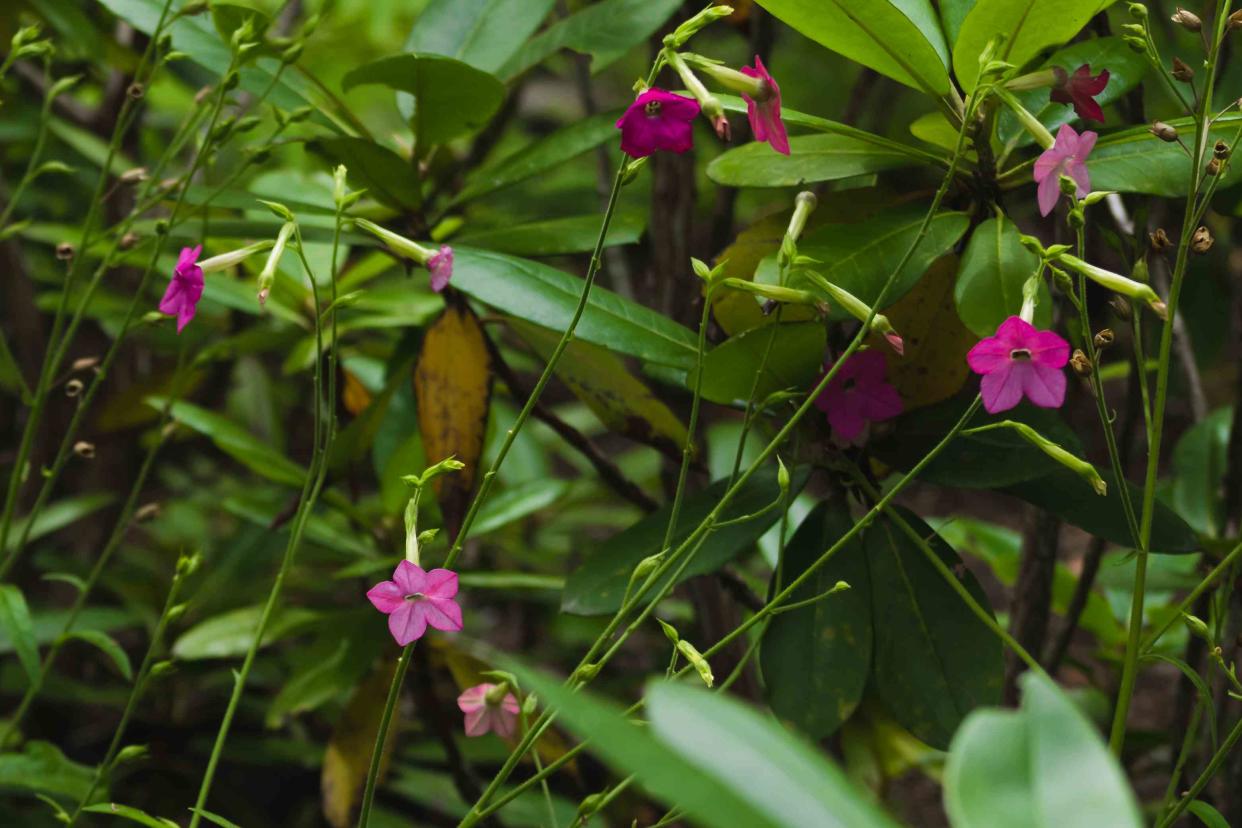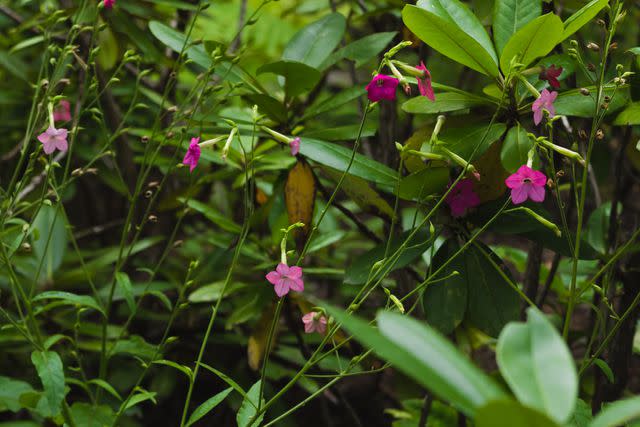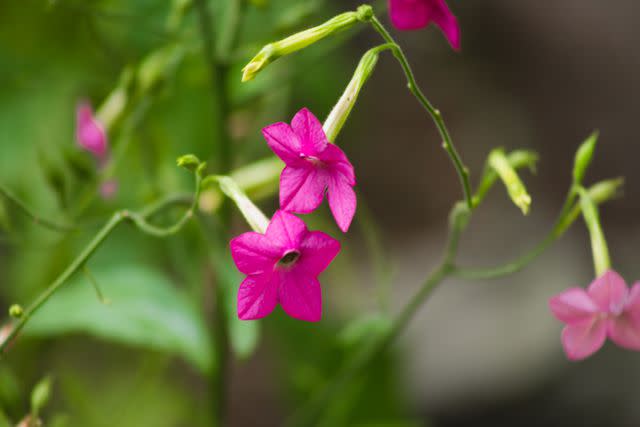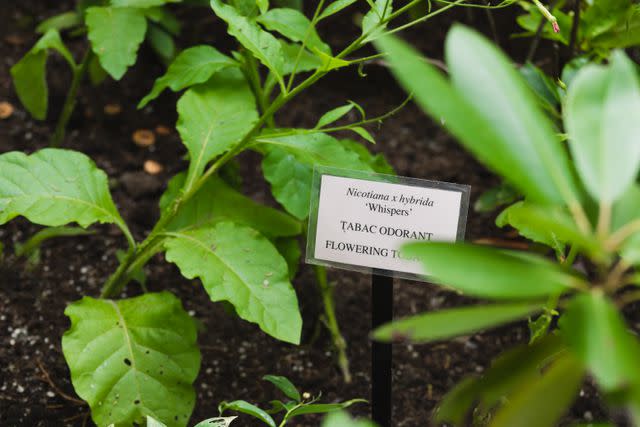How to Grow and Care for Flowering Tobacco

The Spruce / Autumn Wood
Flowering tobacco is a beautiful ornamental plant native to southern Brazil, northern Argentina, Paraguay, Uruguay, and Colombia, that can add color and fragrance to the garden. It features fuzzy, sticky foliage and flower stalks decorated with clusters of blooms. The plant is fast growing but be aware it is toxic to humans and pets.
Common Name | Flowering tobacco, jasmine tobacco, sweet tobacco, winged tobacco |
Botanical Name | Nicotiana alata |
Family | Solanaceae |
Plant Type | Perennial, herbaceous |
Mature Size | 3-5 ft. tall, 1-2 ft. wide |
Sun Exposure | Full, partial |
Soil Type | Moist, well-drained |
Soil pH | Acidic, neutral, alkaline |
Bloom Time | Summer, fall |
Flower Color | Yellow, green, white, pink, red |
Hardiness Zones | 10-11 (USDA) |
Native Areas | South America |
Toxicity | Toxic to humans, pets |
Flowering Tobacco Care
Flowering Tobacco is a very easy plant to grow. Here are the main care requirements:
Plant at least two weeks after your average last frost date.
Plant in a sunny spot in warm, well-drained soil. Cold, wet spring soil can encourage root rot and other diseases.
Allow for adequate spacing when planting, at least 12 to 14 inches.
Water regularly as these plants are not tolerant of drought.



Light
Plant your flowering tobacco in full sun to part shade. At least six hours of sunlight on most days is ideal. In very hot climates, provide your plants with shade from hot afternoon sun.
Soil
Flowering tobacco can tolerate several soil types and a wide pH range from acidic to alklaline as long as there is good drainage. It prefers soil that is rich in organic matter.
Water
This plant likes consistently moist soil, so water whenever the top inch feels dry. Established plants can tolerate drought conditions for short periods. Flowering tobacco in containers needs more frequent watering to keep the soil evenly moist. This can be daily on hot summer days.
Temperature and Humidity
Flowering tobacco likes moderate temperatures and isn't overly picky about humidity. It will struggle in extreme heat and succumb to cold temperatures. It is mostly grown as an annual that is discarded at the end of the season and is not overwintered.
Fertilizer
Flowering tobacco prefers rich soil, which allows it to put on its best show of blooms. Feed immediately after planting with a balanced organic fertilizer. Then, continue to feed monthly throughout the growing season each year, which lasts from early summer until the first frost in the fall.
Types of Flowering Tobacco
There are several varieties of flowering tobacco that range in size, coloring, and other attributes. They include:
'Lime Green': This plant reaches around 2 feet tall and features lime green, very fragrant flowers.
'Nicki Red': This variety grows to about 1.5 feet tall and bears deep red blooms.
'Perfume Deep Purple': This variety features rich purple flowers and grows to about 2 feet tall.
Pruning
Pinch out the center stem of young plants to encourage a bushy growth. The only pruning necessary later is deadheading to stimulate additional flowering. Limit deadheading near the end of the season if you want the plant to self-seed for the following year.
Propagating Flowering Tobacco
The common method of propagating flowering tobacco is from seed. Vegetative propagation from stems, cuttings, or division is not practicable.
How to Grow Flowering Tobacco from Seed
Flowering tobacco is typically propagated from seeds. You can also simply allow it to self-seed in the garden. The seeds are so tiny that it is best to start them in small pots or seed flats. Here's how it's done:
Start the seeds five to six weeks before your average last frost date. Gently press the seeds into the pots filled with potting mix and cover them only with a dusting of soil, as they need light to germinate.
Keep the pots in a bright location at 72 to 78 degrees Fahrenheit. Make sure the soil is well-moistened at all times. Once the seedlings emerge, which takes up to two weeks, they need plenty of sunlight so you might need to supplement natural indoor light with growth lights.
Harden off and transplant the seedlings outside after the last frost.
Potting and Repotting Flowering Tobacco
Smaller, compact varieties of flowering tobacco are excellent for growing in containers so you can enjoy the fragrant flowers on your deck or patio in the evening. The plants are commonly sold in 1-quart containers. Transplant them to a 1-gallon container so they have enough room to grow until the end of the season without requiring repotting.
Common Pests & Plant Diseases
Flea beetles and tobacco hornworms are the most serious pests of flowering tobacco plants. You can recognize flea beetle damage by the presence of myriad tiny holes in the foliage. Floating row covers (a special material placed over the plants) can protect young plants; established plants are seldom damaged to the extent of plant loss. Moreover, diatomaceous earth can be an effective organic deterrent to flea beetles.
If your flowering tobacco plant seems to have lost half of its foliage overnight, look closely for the tobacco hornworm. The thumb-size green caterpillars sport a barb on their tails. This pest presents a paradox for the gardener: The caterpillars mature into hummingbird moths that you might wish to attract to your flowers. But if the caterpillar damage is bothersome, you can handpick the pests (with gloves) off the plants or apply Bacillus thuringiensis, a bacterium that acts as a natural pesticide.
Furthermore, these plants have good resistance to disease but they are susceptible to tobacco mosaic virus. The disease can cause stunted growth and yellowing of the foliage. Infected plants should be dug up and burned to prevent the virus from spreading.
How to Get Flowering Tobacco to Bloom
Flowing tobacco should produce trumpet-like, star- or bell-shaped flowers throughout the season in a range of colors from pure white to pink, red, and purple. If your plant is not blooming, lack of sunlight or water are the two most common causes. Container-grown plants can be easily moved to a sunnier spot and be sure to keep them in rich soil that remains consistently moist.
Frequently Asked Questions
Is flowering tobacco an annual?
Flowering tobacco is botanically a short-lived perennial that is usually planted as a fast-growing annual.
What does flowering tobacco smell like?
The scent of the flowers is reminiscent of jasmine, hence its common name, jasmine tobacco.
Can you smoke flowering tobacco?
The plant is grown for its ornamental appeal and not intended for smoking. The cultivated tobacco grown for smoking is Nicotiana tabacum, a different species.
Read the original article on The Spruce.

